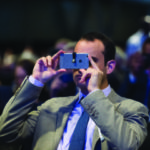As a senior digital marketing manager at Microsoft, Kaila Bongiovanni was accustomed to targeting executives from top accounts for the CIO Summit, one of the software company’s flagship events. Each year in October, 250 leaders in the technology space gather at Microsoft headquarters in Redmond, Washington, for an advanced-level discussion on the latest in mobile workforce solutions, big data, cloud computing, IT security, and more.
But four years ago, Bongiovanni had a good question: Why were they restricting the content to an intimate, elite audience who could only attend in person? “We asked ourselves, why not take the Summit and amplify it?” Bongiovanni said. “If we could extend the reach of the audience, we could increase our ROI.”
Fast-forward to today, and that ROI has skyrocketed. The 2014 CIO Summit welcomed attendees from 39 countries to the virtual experience that Microsoft debuted in 2011, and Bongiovanni says registration numbers are growing substantially. How did she and her team manage such a big transformation?
Many organizations assume they can deliver an on-site program to remote attendees without any alterations. But Bongiovanni points out that the face-to-face experience naturally includes some gaps for viewers at home. “An in-person event often has a morning break, a lunch break, and an afternoon break,” she said. “That’s a lot of unfilled time where it’s easy to lose someone at home; you simply can’t go dark online.”
With this in mind, Microsoft builds a “stage within a stage” on site at the CIO Summit. As soon as in-person attendees have a break, Bongiovanni’s virtual team switches to their own content, presented with a live, TV-style host. “We look at the breaks as opportunities for the virtual team to produce our own significant event that features exclusive online content,” Bongiovanni said. For example, virtual viewers might see a fun, engaging “backstage” chat with a keynote speaker who appeared earlier. Or they might be invited to answer poll questions or participate in a Twitter contest to win gift certificates for Microsoft products.
All of these efforts are designed to keep the attention of viewers looking at a screen at home or in their office — a process that Bongiovanni says presented a challenge at first. When the Summit was exclusively a face-to-face event, much of the content was packaged in traditional 90-minute blocks. But that lengthy approach doesn’t resonate with easily distracted remote attendees. “You can’t think that you can simply show up with a camera crew and share what’s happening at the live event,” Bongiovanni said. “We’re working to make everything snappier and more interactive, so we don’t lose the online audience.”




